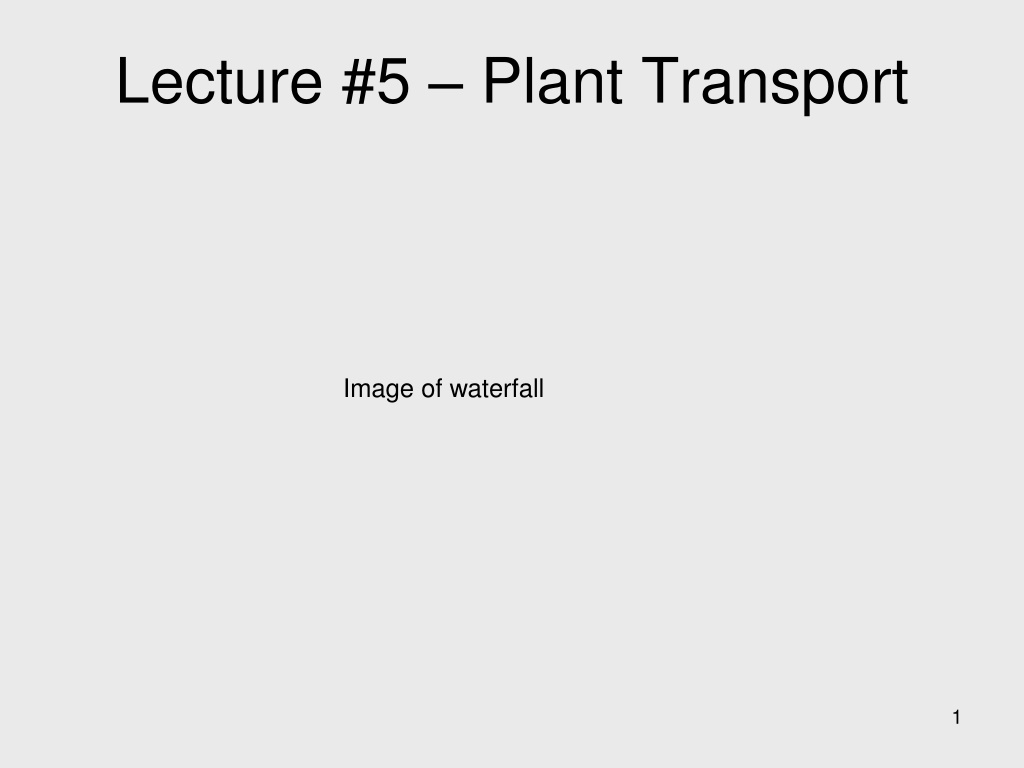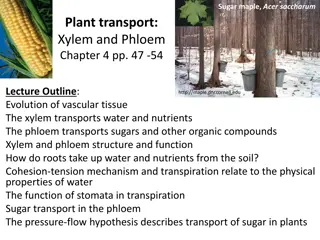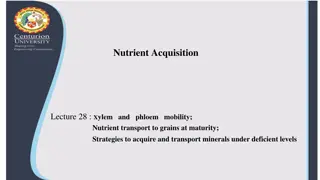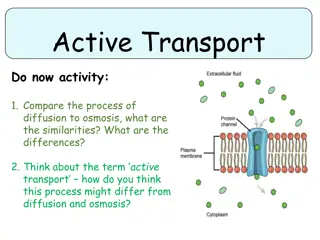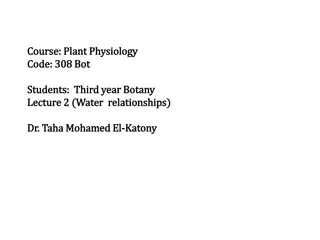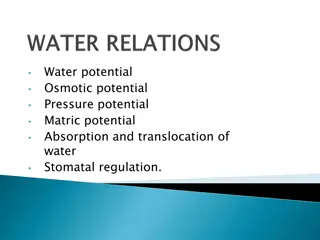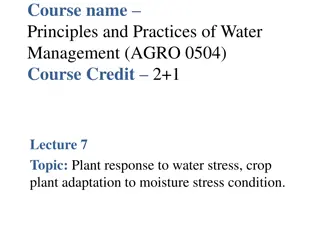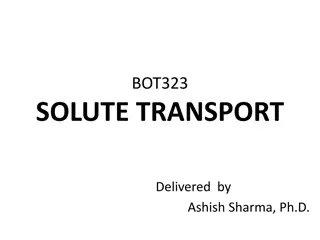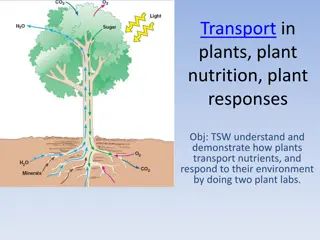Understanding Plant Water Transport Mechanisms
Explore the intricate process of water movement in plants through essential concepts such as water potential, transpiration, and the pressure flow model. Discover why water is crucial for plant metabolism, nutrient uptake, and gas exchange, as illustrated in captivating diagrams. Learn how water potential control guides water flow from high to low potential areas, including its universal application in natural landscapes like waterfalls.
Download Presentation

Please find below an Image/Link to download the presentation.
The content on the website is provided AS IS for your information and personal use only. It may not be sold, licensed, or shared on other websites without obtaining consent from the author. Download presentation by click this link. If you encounter any issues during the download, it is possible that the publisher has removed the file from their server.
E N D
Presentation Transcript
Lecture #5 Plant Transport Image of waterfall 1
Key Concepts: The importance of water Water potential: = P - s How water moves gradients, mechanisms and pathways Transpiration water movement from soil to plant to atmosphere The pressure flow model of phloem transport 2
WHY WATER??? Required for metabolism and cytoplasm Nutrients are taken up and transported in water-based solution Metabolic products are transported in water- based solution Water movement through the plant affects gas exchange and leaf T Diagram movement of water through a tree 3
Water Potential (): Controls the movement of water A measure of potential energy Water always moves from an area of HIGH water potential to an area of LOW water potential Controlled by physical pressure, solute concentration, adhesion of water to cell structures and to soil particles, temperature, and gravity = P - s 4
Diagram water moves from high water potential to low water potential, sometimes toward a negative value; same next 3 slides 5
7 minus 4 is MORE NEGATIVE than minus 1
High Low 8
Diagram water potential is universal, including with waterfalls 9
Water Potential (): Controls the movement of water A measure of potential energy Water always moves from an area of HIGH water potential to an area of LOW water potential Controlled by physical pressure, solute concentration, adhesion of water to cell structures and to soil particles, temperature, and gravity = P - s 10
P Pressure Potential By convention, set to zero in an open container of water (atmospheric pressure only) In the plant cell, P can be positive, negative or zero A cell with positive pressure is turgid A cell with negative pressure is plasmolyzed A cell with zero pressure is flaccid 11
Turgid P > 0 Plasmolyzed P < 0 Flaccid P = 0 12
What are the little green things??? Micrograph photosynthetic cells: turgid on left, plasmolyzed on right; same on next 3 slides 13
Critical Thinking How can you tell this tissue was artificially plasmolyzed? 15
Critical Thinking How can you tell this tissue was artificially plasmolyzed? 16
Crispy means plasmolyzed beyond the permanent wilting point Image turgid plant on left, plasmolyzed on right 17
s Solute Potential s = zero for pure water Pure H2O = nothing else, not a solution Adding solutes ALWAYS decreases the potential energy of water Some water molecules now carry a load there is less free water s s s 18
Remember, = P s Diagram effect on water potential of adding salts to solutions separated by semi-permeable membrane 19
= P s Pressure can be +, -, or 0 Solutes always have a negative effect Simplest way to calculate is by this equation 20
Flaccid cell in pure water what happens??? ..what do you know??? .what do you need to know??? 21
Flaccid cell in pure water what happens??? ..what do you know??? .what do you need to know??? 26
Hands On Prepare a section of plump celery and stain with T-blue Examine and describe Introduce a drop of salt water Any change??? Examine the stalk of celery that was in salt water vs. one that was in fresh water Explain your observations in your lab notes. 35
Water Movement Osmosis the diffusion of water one molecule at a time across a semi-permeable membrane Controlled by both P and s Bulk Flow the movement of water in bulk as a liquid Controlled primarily by P 36
Osmosis Diagram osmosis across a semi-permeable membrane; next slide also Critical Thinking: Where does water move by osmosis in plants??? 37
Osmosis Critical Thinking: Where does water move by osmosis in plants??? Cell membrane is semi-permeable 38
Water Movement Osmosis the diffusion of water one molecule at a time across a semi-permeable membrane Controlled by both P and s Bulk Flow the movement of water in bulk as a liquid Controlled primarily by P 39
Water Movement Osmosis the diffusion of water one molecule at a time across a semi-permeable membrane Controlled by both P and s Bulk Flow the movement of water in bulk as a liquid Controlled primarily by P 40
Critical Thinking Where does water move by bulk flow in plants??? 41
Critical Thinking Where does water move by bulk flow in plants??? 42
Routes of water transport soil root stem leaf atmosphere Cell Wall Cell Membrane Diagram apoplast, symplast and transmembrane pathways; same on next slide Cytoplasm 43
Routes of water transport soil root stem leaf atmosphere Cell Wall Cell Membrane Cytoplasm 44
The Casparian Strip is a band of suberin in the transverse and radial (but not the tangential) walls of the endodermis cells Water CANNOT PASS THROUGH the Casparian Strip Water must GO AROUND the Casparian Strip through the tangential face of the endodermis 46
The Casparian Strip is a band of suberin in the transverse and radial (but not the tangential) walls of the endodermis cells Water CANNOT PASS THROUGH the Casparian Strip Water must GO AROUND the Casparian Strip through the tangential face of the endodermis 47
Critical Thinking Apoplast water is forced into the symplast at the Casparian Strip What does this mean for the water??? What is the function of the Casparian Strip??? 48
Critical Thinking Apoplast water is forced into the symplast at the Casparian Strip What does this mean for the water??? What is the function of the Casparian Strip??? 49
Critical Thinking Apoplast water is forced into the symplast at the Casparian Strip What does this mean for the water??? What is the function of the Casparian Strip??? 50
